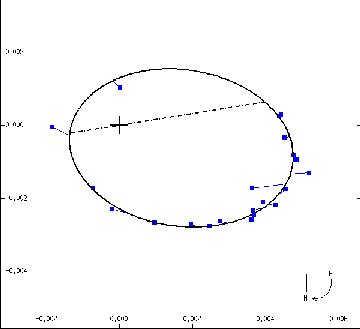
 |
The interferometer reveals the tight orbit of fifth magnitude Theta Aquilae B as it orbits third magnitude Theta Aql A, whjich lies at the cross (in reality the two orbiting a common center of mass between them). The numbered marks on the axes (hard to read here) are just 0.002 seconds of arc apart. A fit of an ellipse to the partially observations (coupled with spectroscopy) gives an orbital period of 17.123 days and an average orbital size of 0.28 AU (which from theoretical analysis of the stars themselves is probably more like 0.24 AU). The elliptical orbit is seen as tilted by 36 degrees to the plane of the sky. (From an article by C. A. Hummel et al. in the Astronomical Journal, vol. 110, p. 376, 1995, as given in the Sixth Catalog of Orbits of Visual Binary Stars, W. I. Hartkopf and B. D. Mason, U.S. Naval Observatory.) |